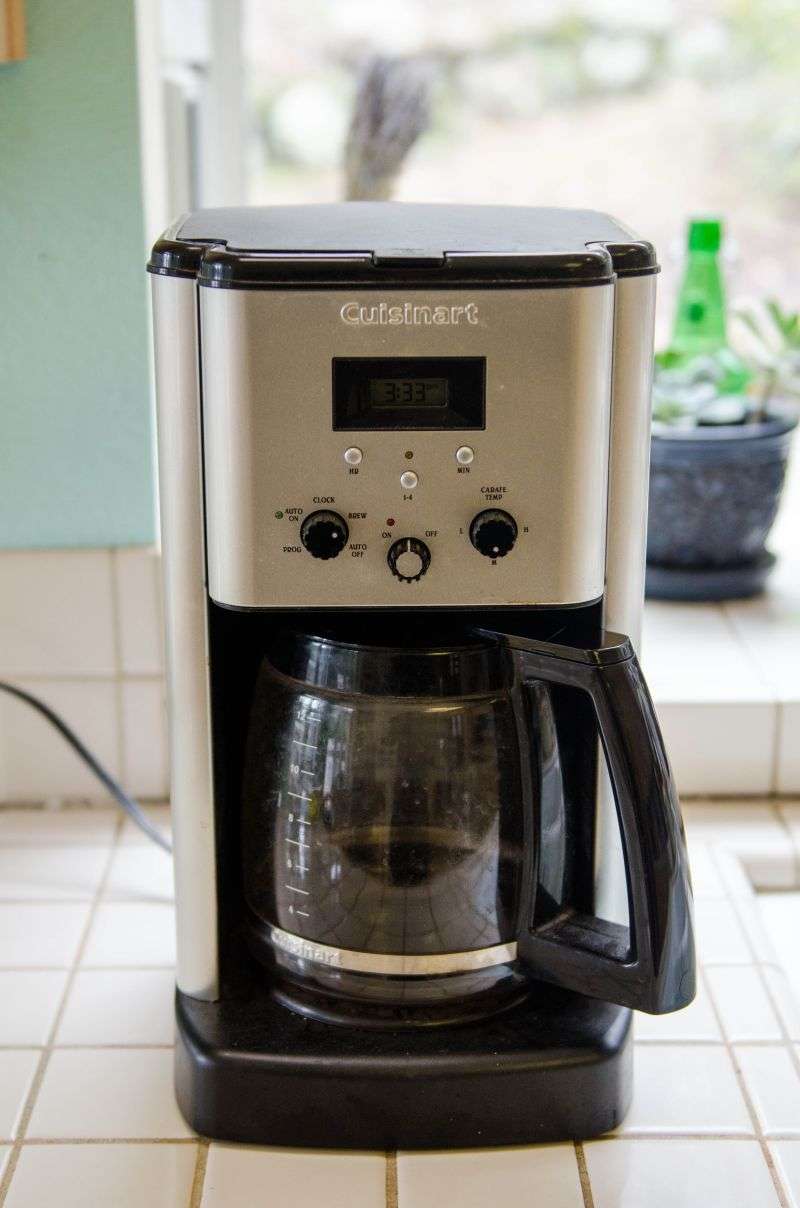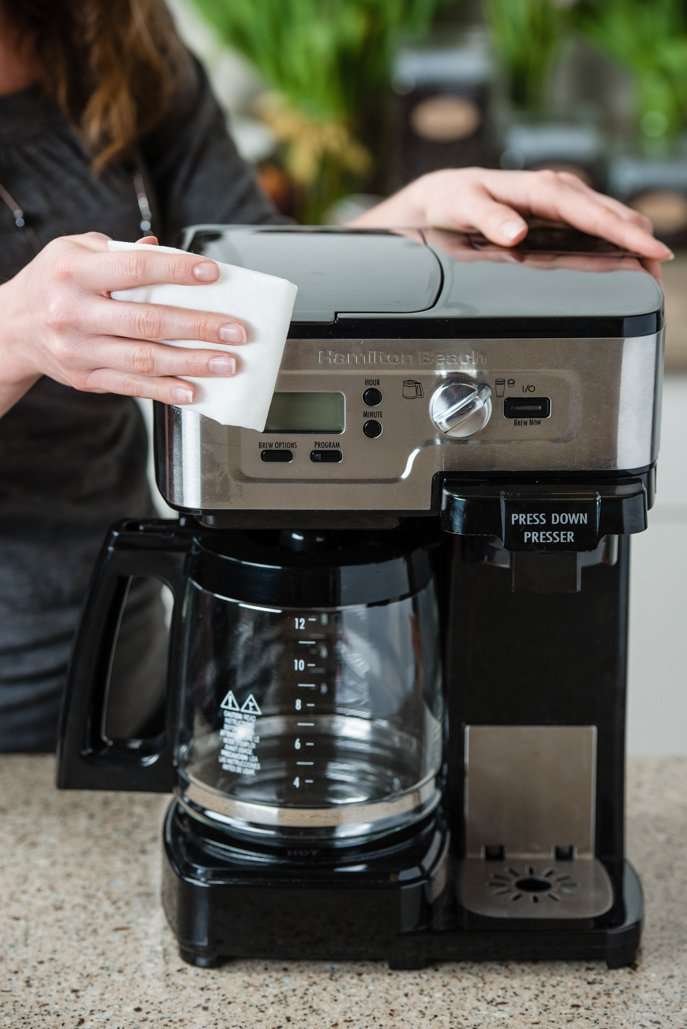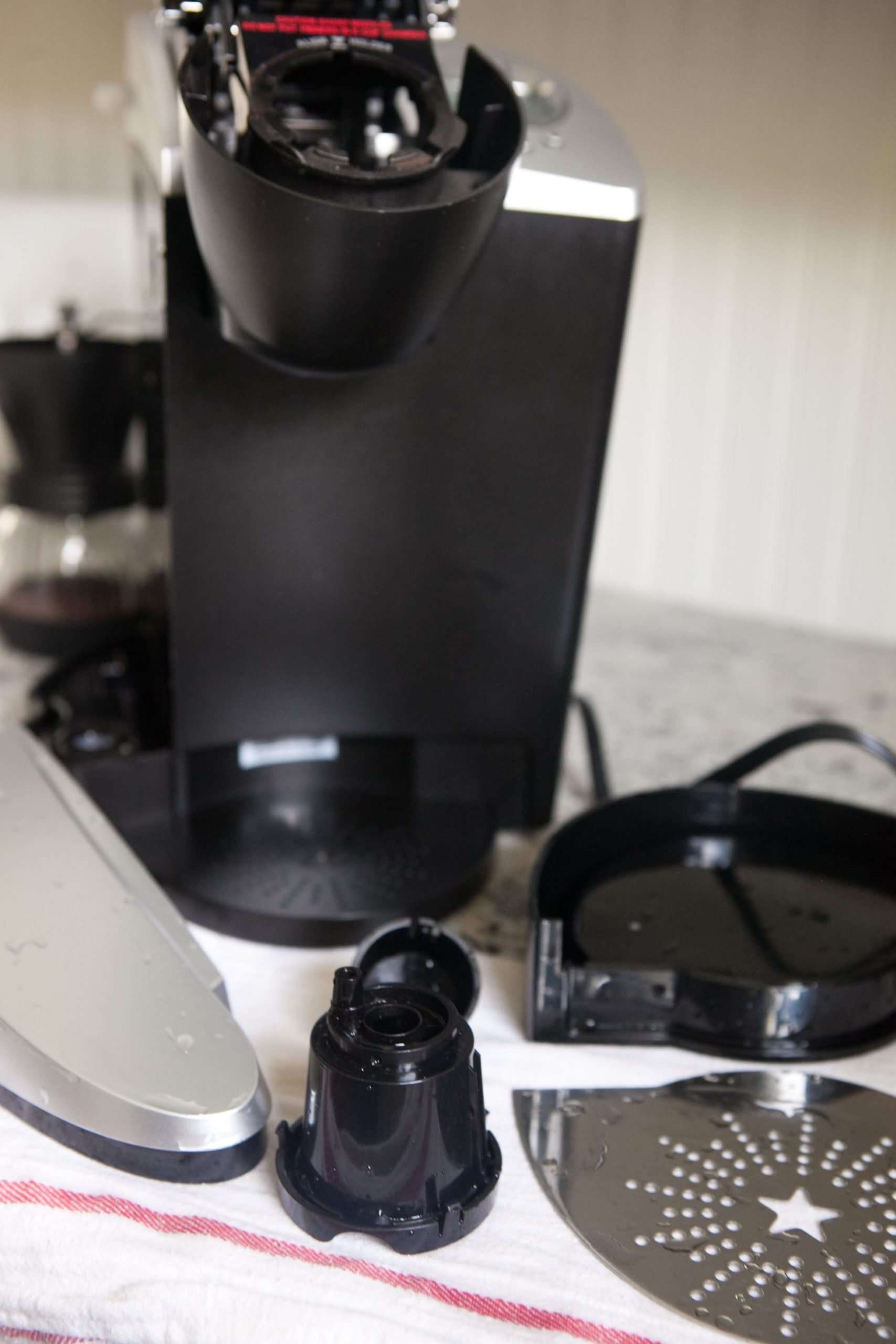Cleaning The Group And Gasket
The Group is the fixture into which you click the portafilter. Inside the group is a rubber ring called a gasket. Carefully use the brush to loosen and dislodge any debris from the gasket and group.
You will see a screw on the underside of the group which you can loosen with a small screwdriver. This will allow you to remove the screen from the group and clear out any coffee grounds or dirt. Make sure to clean both sides of the filter and then replace it and tighten the screw.
Descaling A Bunn Coffee Maker
Unfortunately, cleaning is only half the battle. Coffee machines can build up mineral deposits over time, especially in regions with hard water. Scale deposits are mostly made of calcium that gets left behind when water evaporates on a surface. If you leave scale deposits in your machine, they will build up and could eventually clog your machine entirely.
Thankfully, descaling a Bunn coffee maker is a relatively quick and painless process. Heres how to do it.
- Make a solution of one part vinegar to two parts distilled water. Vinegar is acidic and can easily break down calcium deposits. Make enough solution to fill your Bunns coffee pot.
- Pour the descaling solution into your coffee maker and initiate a brewing cycle.
- Perform at least three to five rinses by running a brewing cycle with only water. If you dont rinse the machine enough after descaling, your coffee will have an unpleasant vinegar taste.
What Can Happen If I Drink Moldy Coffee
Though you might only have 1-2 cups each day, moldy coffee can cause adverse health reactions. This is especially true for people with allergies, compromised immune systems, and other underlying health conditions. Mold spores can trigger side effects like sneezing, sinus blockage, headache, chronic respiratory infections, loose stools, bloating, and upset stomach.
Read Also: How Much Caffeine In Starbucks 2x Caffeine K Cups
Turn The Coffee Machine On
Now that the water reservoir has been filled with the vinegar and water mixture, add a filter and turn the coffee machine on.
There is no need to do anything special, just turn the coffee machine on the same way you would if you were making a pot of coffee and let it run though a brew cycle. Do not add coffee grinds unless you want to drink a pot of the most disgusting coffee you have ever had in your life!
Once the vinegar and water solution has worked its way through your coffee machine and is inside the coffee pot, let it sit for 30 minutes to one hour. The time should depend on how dirty your coffee pot was when you started. The dirtier the pot, the longer you should let the mixture sit.
Directions For Cleaning A Coffee Maker

Make sure your coffee pot is cool before you begin cleaning.
Removable Parts
Machine Exterior
Descaling the Interior
Since both Simple Green All-Purpose Cleaner and hard water mineral scale are alkaline, we recommend using acidic white vinegar to remove mineral scale buildup inside your coffee maker.
Don’t Miss: Does Coffee Cause Uric Acid
How To Clean Your Coffee Machine
*Free same day delivery with Zoom2U is available on machine orders in selected metro postcodes only. Free Standard Delivery with Toll IPEC is available with all machine orders to all other metro and regional postcodes. Eligible delivery methods will be displayed in step 2 of the checkout based on the postcode selected.
The Best Way To Clean A Moka Pot
Stovetop coffee makers like moka pots require more daily diligence than automatic pots. However, these green options are built to last forever…assuming you clean them correctly. The Moka pot should never under any circumstances be cleaned with soap, harsh brushes, or dishwashers. These can strip away the good coffee oils that line the stainless steel which will also affect the flavor of your coffee. 1. After each use, wait for your stovetop coffee maker to cool down. 2. Take the machine apart and rinse under warm water. 3. Either use a clean microfiber cloth or allow each part to air dry before reassembling.
Recommended Reading: How To Redeem Community Coffee Coupons
How Much Vinegar Does It Take To Have A Clean Coffee Maker
A 12-cup coffee pot makes 12, 5-ounce cups of coffee, or 60 ounces total.
Youll need 30 ounces of vinegar and 30 ounces of water to deep clean it.
A 10-cup coffee pot makes 10, 6-ounce cups of coffee, so it also holds 60 ounces total.]
Youll need 30 ounces of vinegar and 30 ounces of water to decalcify it.
- Start by soaking a charcoal filter in a cup of water for approximately five minutes.
- While the new filter is soaking, remove the old filter by gently pulling the filter holder upwards.
- Remove the clip that holds the filter in position by pressing on either side.
- Discard the spent filter. After the new filter has soaked for five minutes, rinse it for a minute. Rinse the filter holder as well as the bottom clip.
- Insert the new charcoal filter into the filter holder and reinstall the clip that holds it in position.
- Turn the dial to the month where you should replace the filter. Reinstall the filter holder within the water reservoir by resolutely pressing until it locks into place.
As soon as that is done, you will be able to brew coffee for a couple of months without having to stress about the filter
How Often Should You Descale
Many people wonder how often they should descale their coffee machine and, unfortunately, its impossible to give a one-size-fits-all answer. If you live in an area with very hard water, you might have to descale your machine as often as once a week. On the other hand, if your water isnt hard, you might only have to describe it once or twice per year.
An easy way to judge your waters hardness level is to look in your bathtub and sinks. If there is a white deposit that forms around the drain, you have hard water. If youre still unsure after checking your drains, you can purchase a water testing kit and determine your waters hardness level quantitatively. However, its usually not necessary to go into that level of detail.
Don’t Miss: How To Clean Mr.coffee Coffee Maker
How To Clean Your Coffee Maker In 6 Six Easy Steps
A guide to cleaner and better-tasting coffee.
If the thought of sipping down some coffee and coliform bacteria makes you want to scrub your tongue with a steel coat brush, itâs best to clean out your coffee maker every now and again.
If you donât, yeast, mold, and other bacteria can grow in there, and believe us when we say theyâre not as tasty as coffee creamer.
Some sources cite that roughly half of all humans admit they donât clean their coffee maker nearly enough, making their machines a bit, err, unpalatable. Fear not, weâve got the goods on how to make yours look like new.
If you havenât cleaned your coffee maker in a while we recommend deep cleaning the whole thing. After that, you can keep up regular maintenance without as big of a hassle. The idea is this: disassemble your coffee maker piece by piece, and tend to each part separately. Some items can be thrown in the dishwasher, others have to be manually cleaned.
How Often Do You Need To Perform A Vinegar Cleaning
Even though it is really easy to do, you only need to clean your coffee machine with vinegar about once every two months. Naturally, you should increase your cleaning schedule if you use the coffee maker on a more regular basis.
Vinegar decalcifies your coffee machines interior and the inside of your coffee pot. Removing mineral buildup makes your coffee machine look newer and ensures it performs better, which means better-tasting coffee.
If your coffee machine uses a reusable, mesh filter, you can take it out and soak it in a half and half mixture of vinegar and warm water. Again, this removes unwanted coffee residue and helps break up any mineral deposits that have built up in the mesh wiring.
Read Also: Mocha Cookie Crumble Frappuccino Have Caffeine
How To Clean Your Keurig Coffee Maker With Vinegar
Keurig coffee makers are among the most effective and most well-liked coffee makers on the market. Theyre also quite easy to wash with vinegar.
To do this, you can mix vinegar with a combination of equal parts water and white vinegar through the machine.
Pour the mixture into the reservoir, activate the machine, press the cycle button, and let the mixture pour out into the cup.
You have to descale your Keurig multiple times depending on the level of dirt.
How To Clean Your Coffee Pots And Pod Coffee Makers

by: Jamie | July 24, 2018
What gets used every day but rarely gets the cleaning attention it deserves? If you said coffee maker, you are correct. The coffee maker is most peoples source of energy and smiles in the morning but sadly they rarely get cleaned as often as they should. Its best to wash the removable parts daily and the remainder at least once a month. This removes and prevents hard water minerals and calcium deposits from building up and causing your machines to perform poorly.
If you have a traditional coffee maker , you probably wash the carafe after making the days pot of coffee but do you wash the reservoir too? Even though you probably use a coffee filter when making your morning brew, you still need to clean everything regularly. Fill the coffee makers water chamber with equal parts white vinegar and water. Using a paper filter, allow to brew until half the chamber is empty. Turn the coffee maker off and let it sit for 30 minutes, then finish brewing. Rinse the machine by using a new paper filter to brew a pot of clear water.
Keeping your coffee maker clean is the key to keeping the coffee flowing. Regular cleanings prevent buildup of minerals and calcium deposits and ensures delicious tasting coffee. A clean coffee maker looks great in a clean kitchen so call Dust and Mop to schedule your regular home cleaning.
Recommended Reading: How Much Caffeine Does Folgers Coffee Have
Mix The White Vinegar And Water
To begin cleaning your coffee maker, fill the water reservoir with a half and half mixture of distilled white vinegar and lukewarm water. Fill the reservoir as if you were going to make a full pot of coffee.
If your coffee maker and pot are particularly dirty, you can increase the ratio of vinegar to water to around two parts vinegar to one-part water.
The vinegar will sanitize the water reservoir as well as the interior of the coffee maker and the coffee pot. It also dissolves mineral deposits within the coffee maker, which can affect performance and alter the flavor of your coffee.
Mix Vinegar And Water
To clean your coffee maker, begin by filling the reservoir with a mixture of half white distilled vinegar and half water. You can increase the ratio of vinegar to water if your coffee maker has a particularly nasty case of buildup. The vinegar not only sanitizes the coffee maker and carafe, but it will also dissolve any accrued mineral deposits.
Related: Here’s How Often You Should Be Cleaning These Common Kitchen Appliances
Also Check: Does A& w Root Beer Have Caffeine In It
Frequent Care Is Easy Care
Keep your coffee maker at optimal cleanliness by immediately tossing soggy coffee grounds in the garbage and drying any wet parts with a microfiber towel. To prevent trapping moisture , leave the basin and filter cover open after every brew. If your device contains a charcoal filter in the basin, replace it regularly according to the manufacturers instructions.
A Clean Machine Not Only Looks Better It’ll Give You Better Tasting Coffee
If you’re an espresso purist you’ll want to clean your coffee machine regularly, as built-up oils and other deposits in the machine will taint the flavour of your brew.
Coffee oils and residues are harder to shift if they’re allowed to dry and harden.
Read on to find out how to look after your coffee machine.
You May Like: Clean Mr. Coffee
How To Properly Clean Your Coffee Maker
We use our coffee makers daily. Unfortunately we dont clean it as often as needed. A proper cleaning will help with any health issues, improve your coffee taste, eliminate any buildup that will cause your coffee to taste bitter, and stop the best and mold from forming! This could impact your health and cause an allergic reaction.
Cleaning your coffee maker often will help elevate these problems. Cleaning the cups you use are essential also. A proper cleaning will eliminate any coffee grounds and oils left behind. Hand washing the exterior can be done with warm soapy water. Clean all areas including the warming plate where spills occurs and burnt coffee often rests.
Rinse thoroughly and rinse again. If need be run another pot of water through your machine for a final rinse.
A clean coffee maker and cups we use will enhance our coffee taste and it is important for a healthy cup also.
Thank you.
Cleaning Your Coffee Carafe With Rice
Another great way to get stains out of your carafe and have it shine like new is to use rice. Rice is a natural absorbent. You can mix a bit of rice in with dish soap and warm water as you are cleaning it.
The rice will soak up the leftovers, just make sure not to rub too hard, or you could end up with a bigger mess. Rice is another natural and cheap way to clean a coffee maker, but getting the rice the right texture may take a few tries.
Recommended Reading: How To Clean Mr.coffee Maker With Clean Button
Consider Baking Soda To Clean Things Up
Finally, you can use baking soda to clean your coffee maker, much in the same way as you would use the previous methods. Simply dissolve about a quarter cup of baking soda for every cup of water in your carafe, and brew normally. You can let the baking soda and water cool and scrub the accessible surfaces afterward if you want, but you can also just do a rinse cycle of regular water brewed through the machine.
While I havent found this method as effective as some of the others on the list, many coffee lovers swear by it. As an added bonus, baking soda doesnt really smell like anythingso there will be no weird smells in your home as a result. However, be careful when scrubbing with baking soda, as plastic surfaces can be scratched up by the particles, while the gritty texture can really help glass and metal components.
How To Clean Your Coffee Maker Inside And Out

Delime, descale, and clean your single serve coffee maker.
Emily Fazio
The convenience of single-serve coffee makers is unmatched, but unlike a traditional coffee maker, many models retain water in a reservoir for long periods of time leading to mold and mineral deposits. Whether you operate a Keurig, De’Longhi, Lavazzo, or one of the many other brands available, signs that it may be time to clean your coffee maker include:
- Longer than usual time to brew a cup of joe
- When you expect a full cup of coffee but the brewed batch only fills half of your cup
- Extra grounds or granules in your brewed cup
- Any unexpected, moldy or mildew-y smells
- Mineral buildup on visible parts of the machine
Mineral deposits associated with hard water buildup, whether visible to the eye or not, are responsible for many of these problems associated with a single-serve coffee maker. If you have hard water, you may notice a need to descale the inside of your machine more often.
Follow these simple steps for cleaning an auto-drip coffee maker for a germ-free home brewer and a fresh tasting cup of joe.
Clean That Coffee Maker02:23
You May Like: How To Cancel Black Rifle Coffee Subscription
How Often Should You Clean Your Coffee Maker
If you want to keep your coffee maker working like new and producing the best-tasting coffee, make a habit of cleaning it on schedule.
Daily: Wash the removable parts after each use. To remove the oily coffee residue, use hot, soapy water. If you cant get your hand into the pot to scrub it, use a baby bottle brush.* Sprinkle salt or baking soda inside if you need added scrubbing power. Or, put them on the top rack of your dishwasher.
Monthly: To keep your coffee maker in the best condition, clean it monthly using one of these methods. Its best to do this on schedule, even if your machine has a light or button that reminds you to clean it. Those reminders are notorious for not working after a year or so, even though theres plenty of life left in the machine if you keep its pump free of mineral buildup.